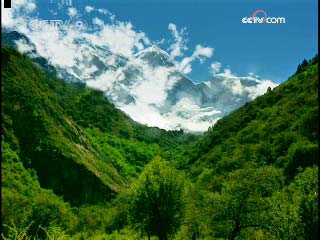------Program code: NS-080828-03054 (what's this?)
Source: CCTV.com
08-28-2008 13:13
 |
Not long after the delivery, the Xia leaves her baby to go in search of food. The Xi is dried by the wind and is soon covered with flecks. When he hides among the flowers, the Xi is hard for his enemies to see. .
The thick virgin forest is the first that the Xi sees of the world.
 |
The normal lifespan of a red deer is about 20 year; that of a spruce is about 500. At the foot of Nanjiabawa, the little red deer, the Xi, and the little Cang Qiong spruce begin growing.
Monks patrol the mountain. Their purpose is to find injured animals and heal them.
Niguo Temple was built in 1818, at the time of the tenth Dalai Lama. During the past two hundred years, the temple has become integrated into this world of mountains and forests, animals and rivers.
The thunder announces the coming of summer.
The amount of oxygen in the air in the valley is only half what it is at sea level. But the ultraviolet light is more than ten times stronger. The shadow of the old spruces shelters the Cang Qiong from the sunshine. If it was exposed to the sun directly, the Cang Qiong would be killed by the ultraviolet light within hours.
The Xi has been left alone by his mother. Deer start feeding at day break, and the Xia has gone with the rest of the herd. But the Xi is still too weak to go.
The Xia is looking for the tasty grass that will help her produce enough milk. It isn’t until dusk that she returns to the Xi and feeds him.
On the alpine meadow, the flowers are in full bloom. They must spread as much of their pollen as they can, before the rainy season.
The dark clouds are driven away by the sunshine, and Nanjiabawa is revealed in all its glory.
On Nanjiabawa’s southern slope, the altitude difference is over 6000 meters. It embraces a whole range of climate zones, from tropical rainforest to broadleaf forest, coniferous forest, alpine meadow and alpine ice field. To climb from the foothills to the peak is like undertaking a journey from Hainan Island, across the East Asian continent and finally reaching the North Pole.
This virtually complete natural world is a priceless biological gene bank.
Most of the forests on the Tibetan plateau are concentrated in this area. Farther to the northwest, the forest thins out. On Mila Mountain, the forest is eventually replaced by shrub, semiarid grassland and arid plateau desert.
Strong ultraviolet light falls on the land.
The red deer begin a mud bath. It’s their way of giving themselves protection against the ultraviolet light and the sting of the gadbee.
Sunlight penetrates the tree cover, and the Cang Qiong’s leaves are exposed.
The strong ultraviolet light burns the Cang Qiong. It has closed all its stomas, but the water is still vaporizing rapidly and its thin cutin layer is nearly breached.
The danger is serious.
Suddenly the environment cools. The Cang Qiong once again enjoys the protection of the old spruces’ shadow.
In the virgin spruce forest, strong sunshine is a deadly enemy of the young plants. They need to develop their cutin layers as quickly as possible, so that they are thick enough to resist the ultraviolet light. .
The Xi is a month old, and getting stronger.
The Xi is looking for food. At the moment, he is only able to eat tender grass. In the winter, when the deer take refuge in the forest, he will be able to digest the thicker fibers of shrubs.
Editor:Yang
